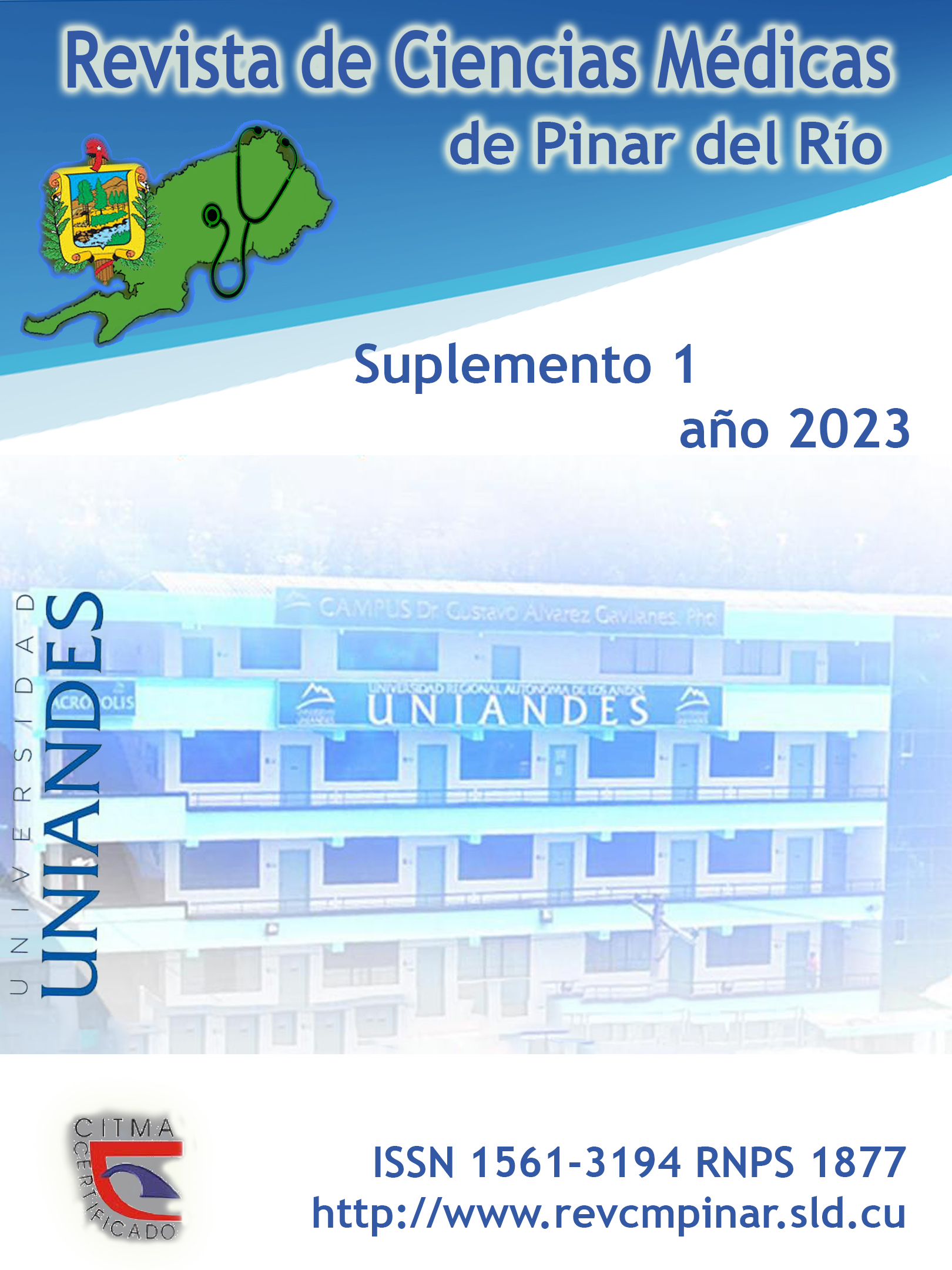Assessment of orofacial harmonization in young women
Keywords:
OROFACIAL, DEGENERATION, BOTULINUM TOXINS, TYPE A, ESTHETICS, DENTAL.Abstract
Introduction: orofacial harmonization achieves, with a series of non-invasive or minimally invasive, therapeutic and aesthetic procedures, regenerate, reposition or return volume and harmony to the tissues that link the smile with the other components of the facial region.
Objective: to evaluate the knowledge of young women about orofacial harmonization, its use and effectiveness, city of Salcedo, Ecuador.
Methods: an observational, descriptive, cross-sectional study was designed to assess the knowledge of young women between 20 and 30 years of age about orofacial harmonization, its use and effectiveness, from September to December 2022, Salcedo city, Ecuador. The universe consisted of 43 women, through simple random probabilistic sampling and according to the inclusion and exclusion criteria, a sample of 30 women was obtained. The study data, tabulated and processed using Microsoft Excel, were obtained through a survey prepared for such purposes.
Results: it was possible to determine that there is ignorance on the part of a large part of the sample about this treatment, 27 % of the women know what orofacial harmonization is while 73 % do not. 60 % of the respondents feel satisfied with their face while 23 % do not. While 17 % of women choose this treatment only for aesthetic purposes while 83 % for their lifestyle.
Conclusions: the passage of time, the loss of dental pieces, aging, sun damage, harmful habits or genetics make patients seek solutions with these treatments to improve their physical and emotional health and accompany aging more effectively.
Downloads
References
1. Carbone A. Armonización orofacial. Casos clínicos. Tomo 1. Amolca [Internet]; 2019 (citado 16/02/2023). Disponible en: http://www.libreriaserviciomedico.com/product/477610/mdm-armonizacion-orofacial-tomo-1---carbone
2. Susanibar F., Douglas, CR., Dacillo C. Fundamentos fisiológicos de la sensibilidad del sistema estomatogná¬tico, en EOS (ed.), Motricidad orofacial. Fundamentos basados en evidencias. [Internet]; 2013 (citado 16/02/2023): 141-176. Disponible en: https://www.researchgate.net/publication/305400434_Fundamentos_fisiologicos_de_la_sensibilidad_del_sistema_estomatognatico
3. Herrera A, Soto Aguirre N. La belleza orofacial inteligente: una reflexión epistémica desde el cliente odontolófogico venezolano. CIENCIA ergo-sum[Internet]. 2022(citado 16/02/2023); 29(2). Disponible en: https://cienciaergosum.uaemex.mx/article/view/15360/13723
4. Navarro C. Belleza inteligente [Internet]; 2013 (citado 16/02/2023) Disponible en: https://quelibroleo.com/belleza-inteligente
5. Christensen G. Elective vs. mandatory dentistry. J Am Dent Assoc [Internet]. 2000 (citado 16/02/2023); 131(10): 1496-98. Disponible en: https://pubmed.ncbi.nlm.nih.gov/11042991/
6. Díaz de Villabona N, Valero N, Rincón F, David C, Velazco Viloria GJ, Solórzano N. Rinomodelación, fundamento morfológico. Acta Bioclínica [Internet]. 2020 (citado 16/02/2023); 10(20): 152-170. Disponible en: https://dialnet.unirioja.es/servlet/articulo?codigo=8929505
7. Herrera A., Aguirre Soto N. La odontología desde la perspectiva de la belleza: armonización orofacial. Revista de la Facultad de Odontología [Internet]. 2022 (citado 16/02/2023); 15(1): 1668-7280. Disponible en: http://dx.doi.org/10.30972/rfo.1515938
8. Machado Filho DA, Germani Vieira M, Tanajura E, Cruz Corrêa B, Marguardt Filho EJ. Planejamento digital em harmonização orofacial-facial design. Simmetria Orofacial Harmonization in Science [Internet]. 2020 (citado 16/02/2023); 1(4):95-104. Disponible en: https://www.redalyc.org/journal/4215/421573359001/html/
Downloads
Published
How to Cite
Issue
Section
License
Authors who have publications with this journal agree to the following terms: Authors will retain their copyrights and grant the journal the right of first publication of their work, which will be publication of their work, which will be simultaneously subject to the Creative Commons Attribution License (CC-BY-NC 4.0) that allows third parties to share the work as long as its author and first publication in this journal are indicated.
Authors may adopt other non-exclusive license agreements for distribution of the published version of the work (e.g.: deposit it in an institutional telematic archive or publish it in a volume). Likewise, and according to the recommendations of the Medical Sciences Editorial (ECIMED), authors must declare in each article their contribution according to the CRediT taxonomy (contributor roles). This taxonomy includes 14 roles, which can be used to represent the tasks typically performed by contributors in scientific academic production. It should be consulted in monograph) whenever initial publication in this journal is indicated. Authors are allowed and encouraged to disseminate their work through the Internet (e.g., in institutional telematic archives or on their web page) before and during the submission process, which may produce interesting exchanges and increase citations of the published work. (See The effect of open access). https://casrai.org/credit/



